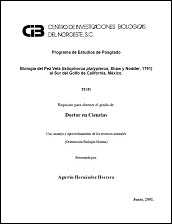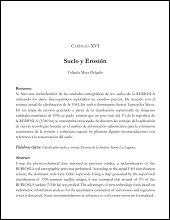USE OF HIGH-SALINITY WATERS TO GROW Kochia scoparia L. Schrad. AS ALTERNATIVE FODDER IN SALINE ENVIRONMENTS IN NORTHWESTERN MEXICO
USO DE AGUAS ALTAMENTE SALINAS PARA CULTIVAR Kochia scoparia L. Schrad. COMO FORRAJE ALTERNATIVO EN AMBIENTES SALINOS DEL NOROESTE DE MÉXICO
Autor
DAVID RAUL LOPEZ AGUILAR
MARIA GUADALUPE RODRIGUEZ QUEZADA
ARMANDO LUCERO ARCE
ARTURO NARANJO MURILLO
Metadatos
Mostrar el registro completo del ítemResumen
"This study examines the effects of different tap water: seawater ratios in the halophytic plant Kochia scoparia, for potential use as fodder in saline agroecosystems of Northwestern Mexico. Salinity postpones initiation of the germination process and after 6 days the decrease in germination with respect to the control in tap water was 9, 44, 77, and 85% in treatments 75:25, 50:50, 25:75, and 00:100 (tap water: seawater ratios), respectively. In treated plants for 20 and 42 days, growth decreased with the increase of sea water in the treatments in both periods. In the initial growth stage of K. scoparia, K+ concentrations in leaves and stem are high, whereas Na+ concentrations are low, indicating selective uptake of K+ and the preferential exclusion of Na+ from the shoot. Consequently, the ability of K. scoparia to counteract salinity partially depends on the levels of K+ available to maintain a high cytosolic K+/Na+ ratio. In more advanced growth stages this species employs a rapid growth strategy in order to dilute salt concentrations, which minimizes salt stress. K. scoparia has high forage quality. The protein and carbohydrate contents were high, whereas the fiber level was low, particularly when seawater proportion was increased. The plants accumulated oxalates and NO3 preferentially in the leaves and stems, which are the edible organs for livestock, but the recorded levels are below those considered toxic for livestock." "Este estudio examina los efectos de diferentes proporciones de agua potable y agua de mar en la planta halófila Kochia scoparia, para su uso potencial como planta forrajera en agroecosistemas salinos del Noroeste de México. La salinidad retarda la germinación y después de 6 días la reducción con respecto al control en agua potable fue de 9, 44, 77 y 85% en los tratamientos 75:25, 50:50, 25:75 y 00:100 (proporción agua potable: agua de mar), respectivamente. En plantas tratadas por 20 y 42 días, el crecimiento disminuyó con el incremento de agua de mar en los tratamientos en ambos periodos. En el crecimiento inicial de K. scoparia, las concentraciones de K+ en hojas y tallo son altas mientras que las concentraciones de Na+ son bajas, indicando una absorción selectiva de K+ y la exclusión preferencial de Na+ del follaje. Por tanto, la habilidad de K. scoparia para contrarrestar la salinidad depende parcialmente de los niveles de K+ disponible para mantener una proporción elevada de K+/Na+ en el citosol. En etapas de crecimiento más avanzadas esta especie emplea la estrategia de rápido crecimiento para diluir las concentraciones de sales, lo cual minimiza el estrés salino. K. scoparia tiene una alta calidad forrajera. Los contenidos de proteínas y carbohidratos fueron altos, mientras el nivel de fibra fue bajo, particularmente cuando se incrementó la proporción de agua de mar. Las plantas acumularon oxalatos y NO3 preferentemente en las hojas y tallos, los cuales son los órganos comestibles por el ganado, pero los niveles registrados están por debajo de aquellos considerados tóxicos para el ganado."
Colecciones
Ítems relacionados
Mostrando ítems relacionados por Título, autor o materia.
-
PROMOCIÓN DEL PERIFITON PARA EL CULTIVO DE CAMARÓN BLANCO: HACIA UNA ACUICULTURA ECOLÓGICA
DOMENICO VOLTOLINA LOBINA; JUAN MANUEL AUDELO NARANJO; MARIA DEL ROSARIO PACHECO MARGES -
Suelo y Erosión
YOLANDA LOURDES MAYA DELGADO


